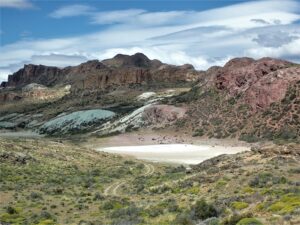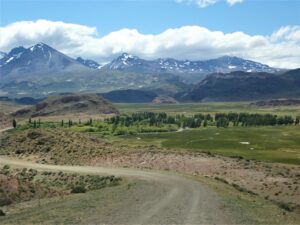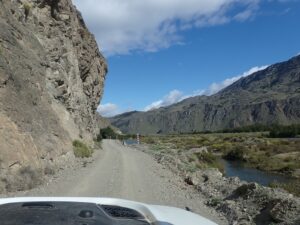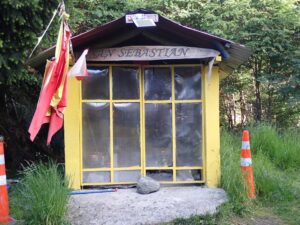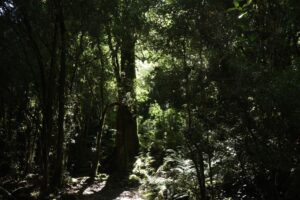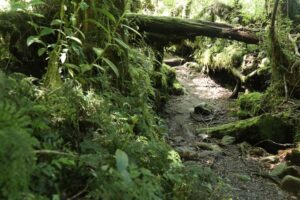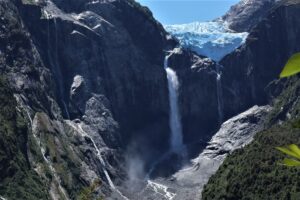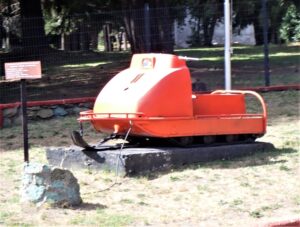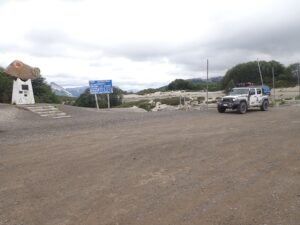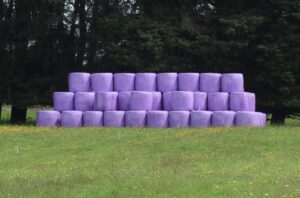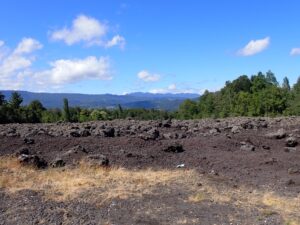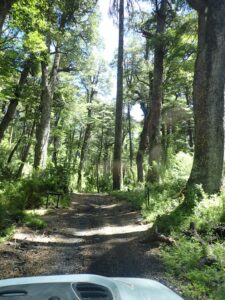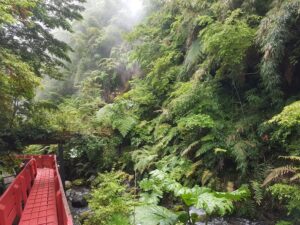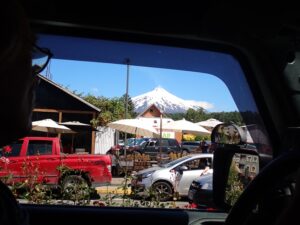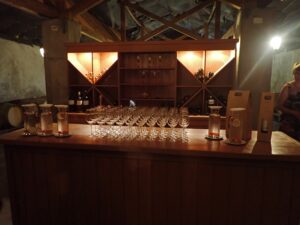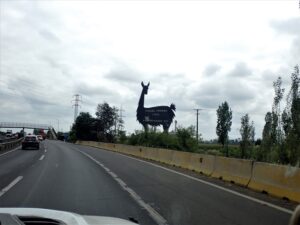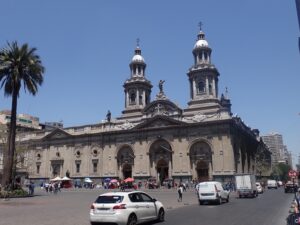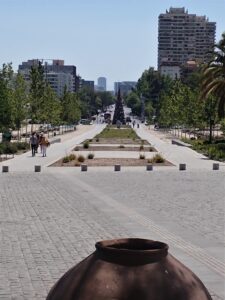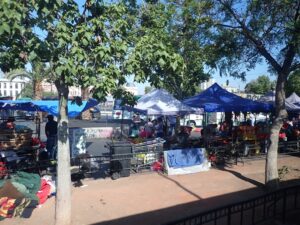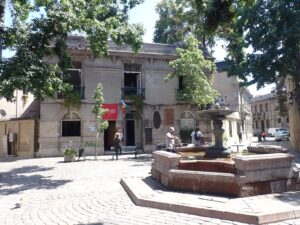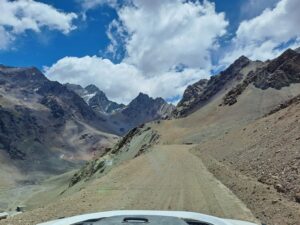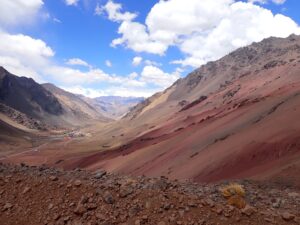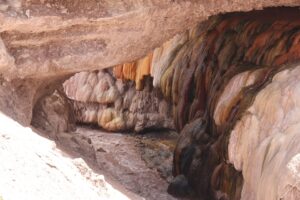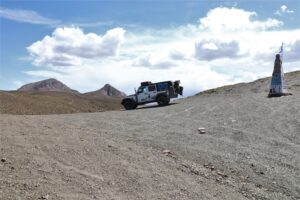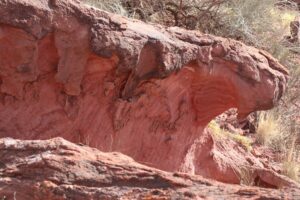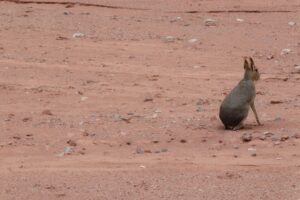>Translated with www.DeepL.com/Translator
(>Pictures at the bottom!)
The Fitz Roy (granite mountain) waved goodbye to us a little bashfully and soon it disappeared in our rear-view mirror. For us, as well as the whole group, we continued northwards on the “Panamericana”. Whether it really is this dream road or not is beyond my knowledge. Here in southern America, people argue about strange things, e.g. who invented pisco (brandy) or where exactly the potato comes from. It’s no different with the “Panamericana”; every country thinks it has the original.
In “Las Horquetas” (Ruta 40) we joined two travel couples for a detour to Chile. One couple wanted to visit relatives on the other side of the Andes, the other couple had seen enough of the wide and flat Argentinean pampas and, like us, were longing for some change and adventure. And to my astonishment (Tom), our tour guide approved this idea and said that it was, after all, our trip, with the caveat that if there were any problems, there would be little to no support. Whether this was the reason that only we – 3 vehicles – dared to make the detour onto the Chilean “Carratera Austral”, or whether it was due to the many hundreds of kilometres of gravel road, we do not know!
But right away: the detour was worth it and after the endless kilometres through the vastness of the Argentine Patagonia we were more than rewarded. The closer we drove towards the mountains, the more varied it became. Chantal and I also enjoyed the benefits of our “mini-camper” and ventured further additional loops before we approached the Argentine-Chilean border. The respective border posts, which are several kilometres apart and only connected by a simple road, consist of a few buildings. The respective national police immediately took care of all customs formalities. On the Argentinian side, everything was over quickly because the World Cup semi-final was taking place at the same time. They even forgot to give us the transit permit, but fortunately Chile showed understanding. For the total of 3 vehicles that crossed the border on this day, this border staffing is probably sufficient and instead of typing our data into a computer, everything was neatly entered into thick books and we were handed handwritten paper for the vehicle.
Already after the wonderful access road, the landscape changed completely: After the dry area east of the Andes, indescribable vegetation proliferated on the western side. Lush meadows on the mountain slopes, dense forests, and the snow-covered peaks with their glaciers completed the visual experience. Wild streams cascaded down from the mountains, and great torrents of water ran through the valley floor. Many things are offered here in terms of tourism; all outdoor activities were already advertised everywhere and the local population was preparing for the upcoming holiday season.
At Lago General Carrera, which is called Lago Buenos Aires on the Argentinian side, we stopped to visit the marble caves. Some operators had already stopped their boat trips because of heavy wind and waves. But we found one that offered one last trip out onto the lake. The 40-minute crossing and return trip was a rocking ride and those sitting outside along the railing were correspondingly wet. At the caves or inlets, the water was relatively calm and we were able to enjoy the natural spectacle in peace.
At the national park “Lago Rosselot” we visited the Colgante glacier (hanging glacier) on the advice of our Fitz Roy guide. Admission to the national park proved to be an almost insurmountable obstacle, as you have to book your visit in advance on the internet. On site, i.e. at the entrance itself, the rangers were stubborn and invoked the prescribed procedure. This was a real hassle; we had to go back to where there was internet to book the entrance and drive back up to the park. Supposedly there was no internet at the entrance outside in the mountain world, but when we arrived again they already knew everything about us and the booked entrance. That we almost gave the glacier, which is not actually a hanging glacier, the cold shoulder is almost understandable for a mountain walker who has seen and climbed on many glaciers. But the walk over the steep moraine, covered with a dense primeval forest, that was the real natural spectacle. I’ve never seen anything like it!
After the “private” Chile adventure, we crossed the Chilean-Argentinean border and followed our group north to “San Carlos de Bariloche”. After all the green beyond the Andes, the steppe-like landscape was no longer such a wasteland, and the closer we got to “Bariloche”, the greener it became on the Argentinian side as well. Around “Lago Nahuel Huapi” it was as green as if we were somewhere in Central Europe. Suddenly it was clear to us that many people from this Central European region settled here a long time ago and, among other things, founded the “Colonia Suiza”. I would also like it there – around the “Lago Nahuel Huapi” 😉
Another crossing over the Andes into Chile. While most of the group members were able to pass the border controls at a relatively fast pace, we were thoroughly examined by the Chileans. Customs and the officials of the Ministry of Agriculture wanted to look into the farthest corner of us, and every box had to be opened. Even the four boxes on the roof had to be taken down and presented to the scrutinising eyes of the officials. Frank – one of our group leaders – said afterwards, laughing, that I probably made a somewhat suspicious impression on them and that was why the inspection was so thorough.
On the Chilean side, we skipped Puerto Montt because the city is no longer safe. When visiting the fish market, the risk of theft from the parked camper van would be relatively high, according to the recommendation of a German beer brewer. At his place we could put all our motorhomes in the garden and once again enjoy a delicious beer from a microbrewery.
Instead of the fish market, we enjoyed the wide landscape, which invited us to “cruise through the countryside” with many lakes and large pastures. During the hike along the flanks of the Osorno volcano, I was almost blown over the slopes by the wind and was glad to be back in the protective jeep to enjoy the onward journey around “Lago Llanquihue”. We were struck by the fact that many Germans had settled in this area. In the evening at the brewer’s, the explanation came that even after the Second World War, many Germans sought protection here from possible persecution by the Allies in Chile.
Below the glowing and active “Villarrica volcano” we spent our Christmas Eve together. Wow, sitting outside, just wearing a T-shirt, letting the delicious meat sizzle on the grill and chatting far into the night – it really was a wonderful evening. Unfortunately, we also had to think about our onward journey on Christmas Day; a very long drive was on the agenda, actually not our “favourite activity” – for us (Chantal/Tom) the distances are often just too far.
So on Christmas Day we reached a vineyard that is run by a Swiss. Besides winegrowing, he also runs an inn with holiday residences, so that he has several mainstays and is not completely dependent on winegrowing. After the guided tour through the vines, we visited the wine cellar and during both activities we learned a lot of interesting facts about viticulture in Chile. Of course, the wine tasting in the cellar was not to be missed before we could enjoy the fine meal in the restaurant.
The next stop west of “Santiago de Chile” was again a long way ahead of us. We skipped the recommended visit to the “Santa Rita” winery, instead we soon left the Chilean motorway again and headed for the Pacific coast. Ah, the Chilean motorways are not to be compared with ours; although paying, there are entrances and exits to individual houses or shops everywhere, trucks park on the hard shoulder and the drivers take lunch in some snack bar, or that here cyclists, tractors or combine harvesters also have a claim to this fast connection. Tia, other countries – other customs 😉
Our detour to “San Antonio” soon turned out to be nerve-wracking; for about 50 km, the road was renewed and adapted to a better standard so that the heavy trucks could reach the seaport faster; other modes of transport than road transport no longer exist in Chile. The many changing traffic routing delayed our journey a lot. On the other hand, we soon saw the Pacific Ocean and were able to follow it a few kilometres in a northerly direction before we drove back through the mountains inland towards “Santiago” and our camp in the orchard west of the capital.
With a German guide who knew the area well, we visited the Chilean metropolis, the big city that actually consists of many individual cities. Already on the way there, he told us a lot about his new home, about Chilean history and the problems of daily life in modern times. Partly very critical and with a certain irony, he got to the heart of many things. Apart from the centre with all its official government buildings, we also roamed through parts of the city where probably not many tourists are taken and class thinking is also commonplace in Chile, especially in the capital. Those who live at the top belong to the better society; those who have the misfortune to live at the bottom probably hardly had the opportunity for advancement.
With “so much city”, we longed for the countryside again and were glad to get out of the urban hustle and bustle again. As soon as we left the agglomeration, we roamed through valleys that were always lined with higher mountains. The daily tour led us to the first high pass and virtually the “baptism of fire” for our jeep: can it handle such heights at all? European cars are not built for heights above 2500m, respectively the engine control is programmed for it. But as we drove up towards “Paso Cristo Redentor”, or “Paso de Uspallata” for the Argentines, our fears were soon forgotten; the landscape was overwhelming and our jeep mumbled contentedly to itself even at 3,800 metres.
The drive down from the pass to Uspallata was also a visual experience and the different rock colours turned the almost barren mountain landscape into a wonderful natural spectacle. It would also have been wonderful all the way down to Mendoza, but the road traffic took up all our attention and the wonderful views had to be neglected.
From “Mendoza” we – Chantal and I – wanted to leave the eastern pampas again and drive through the mountains to the provincial park “Ischigualasgto”. We also wanted to split the route over two days to enjoy the landscape better. So we chugged along the “Camino las Lajas” over two 3’000 metre high passes, former mining areas and the “Cerro Siete Colores” towards Uspallata. In the evening we were a little disappointed to have reached Uspallata first, as we wanted to ride a few more kilometres. But the chosen route via the “Camino las Lajas” only allowed us a very slow pace and we initially underestimated the distance.
In the end, it was good that we stayed in Uspallata the day before. In the morning at breakfast, Chantal broke a tooth in two and dental help was needed immediately. The local dentist had closed his practice for the holidays and so we had to drive down to Mendoza again, where our tour guide was able to find a dentist and make an appointment for us at 7.30 pm. Yes, this is not how we imagined our onward journey and already we were wandering through the alleys of Mendoza in the hope that we would be let in early for treatment.
We were lucky; the dentist interrupted his lunch break and immediately ordered Chantal to the treatment chair. To begin with, the practice was nothing like our dental facilities and even the exterior of the building looked more like a demolition project than a doctor’s office.
Chantal returned after a short time with a swollen mouth. All’s well that ends well – the tooth could be saved and should hold again for the foreseeable future. So we followed – of necessity – the prescribed route from our roadbook in a northerly direction to the provincial park “Ischigualasgto” and national park “Talampaya”. The first park only served as a place to spend the night, but instead we were led through the national park “Talampaya” into the gorge with the petroglyphs and steep sandstone walls. The evening sunlight enchanted the landscape in wonderful colours and the condors flying over our heads rounded off the day.
We enjoyed the last day in 2022 with a joint barbecue with fine side dishes. It was a wonderful end to the year and soon we were toasting to the new year. We are excited to see what new adventures and experiences the coming year will bring us. So; “Happy New Year”!
2023-01-10/Chantal+Tom
>Translated with www.DeepL.com/Translator











